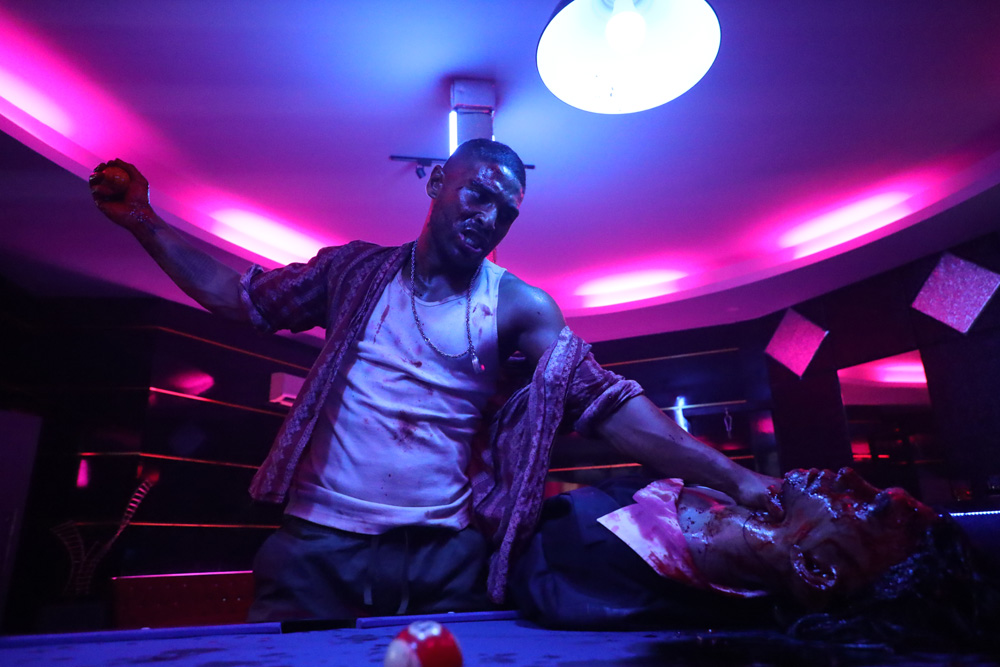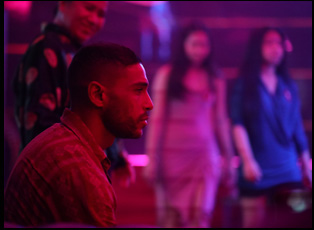It doesn’t seem incidental that the first words of “Mayhem!” are “go off,” though it could hardly be said that director Xavier Gens has ever been one to hold back. Establishing himself at the vanguard of a new generation of fearless French directors such as Christophe Gans, Pascal Laughier (“Martyrs”), Alexandre Bustillo and Julien Maury (“Inside”) and Alexandre Aja (“High Tension”) in the early 2000s with the frenetic thriller “Frontier(s),” Gens has moved across genres yet has distinguished himself without ever letting up on intensity, making him a natural fit in recent years directing action-packed episodes of “Gangs of London” and “Lupin” in between horror films such as “The Divide” and “The Crucifiction.”
With “Mayhem!” Gens takes his talents to Thailand where he sees Samir (Nassim Lyes) attempt to restart his life after serving a prison stretch in his native Paris where only minutes after his paroled, he’s propositioned on the street to start running drugs again. He decides to handle luggage, but on the right side of the law at the baggage claim of a local airport where he starts accruing the cash to start a family with his girlfriend (Loryn Nounay), who has dreams of opening a restaurant while toiling away as a waitress, and their daughter. Still, Sam can’t leave the underworld completely, still participating in prize fights to afford the beachside real estate where the couple intends to put down roots and the owner of the property (Olivier Gourmet) has conditions for the sale that would require him to go back to his old ways, a devil’s bargain if there ever was one.
If seeing Lyes, a former MMA fighter who’s steadily built a career in acting, brawling with bad guys is a main draw, it becomes equally compelling to take in Sam’s internal struggle after Gourmet’s sleazy Narong attempts to make his life a living hell, and his resistance doesn’t only come through his fists but through an iron will he’s worked hard to achieve. As much as the actor lets audiences in, Gens doesn’t allow any space between the camera and Sam, revealing a bruised soul that makes the impact of every blow to the body pale in comparison and leaves no doubt he’ll be able to get the better end of any fight he’s in physically, if not emotionally. It’s as if Sam discovers depths that he never knew he had within himself, which it could be said of Gens as well when delivering an explosive drama and on the eve of the film’s release in America, he spoke about wanting to change things up and the well of influences he drew on to break new ground for himself as a filmmaker, as well as his interest in bringing reality into a process where the action demands him to previsualize every beat for maximum effect and the start of a beautiful and ongoing collaboration with Lyes.
First, it was my desire to tell a story that happened in Eastern Asia because I’m fascinated by this area of the world. It’s a place where you can really create a new Western story. Back in the day, there was the Western and the conquest of United States, so there was the idea of getting a new pioneer arriving in Eastern Asia and developing his new life, giving himself a chance in life to start something something different and reinvent himself in a way and in some way, it was really a chance to reinvent myself as well as a filmmaker and to create something different.
From what I understand, the experiences you had as a producer on “Papicha” and directing episodes of “Gangs of London” really were transformative. What did you want to bring back to directing a feature of your own?
Because I saw the freedom my wife got from “Papicha” to make a film and I was like, “Oh I can really go deeper into the character and create something a bit different.” And from my experience I had with [stunt director] Jude Poyer on “Gangs of London,” I wanted to recreate that feeling of camaraderie we had. We were very good friends in life and I really wanted to get that feeling of kids having fun doing a film together and share that pleasure with an audience, so I combined these two experiences and to refresh the way I was working as well. After that experience, I was exploring new possibilities in the way of filming and doing my staging, my blocking, and telling the stories, so I was really trying to push hard to find a new way to tell story and to tell action as well.
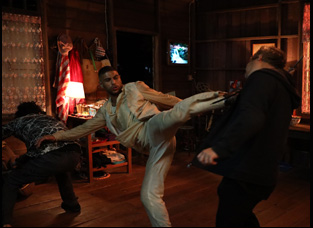
It was super great because I really like to be in foreign country to shoot. I always meet new friends and I’m curious by nature about other cultures, so I really enjoy it. If I could, I would do documentaries about life and different cultures as in National Geographic because I think that’s the richness of our world, and I love genre movies, so I combined those passions by doing movies which are a little bit different [from one another]. That’s why we talk a lot about the amulet in the film — Vithaya [Pansringarm], one of the actors, created one for me after the film and it was really a tribute for him, based on the story we told together. So we really wanted to share an experience [and these] cultural elements about it. That [attention to the amulet] was a way to try to keep in a very respectful way what the actors and the crew can bring to the film and try to apply it, so we can show, we respect the Thai culture and we use our character to send him in an uncharted territory because we are not used to seeing Thai culture on screen the way we shot it, so it was interesting to show like this.
You make beautiful use of the landscape and find great ways to utilize it as the backdrop for action. What was location scouting like?
Yeah, there is a big process of scouting before, first alone with the location crew in Thailand and I had a breakdown [of certain places], but I wanted to see unexpected places and to really adapt and rewrite to those places. I had [looked on] a Google map, so I tried to avoid all the touristy areas. We have seen Phuket many times in movies where they shot the beach and the southwest of Thailand. So I went the opposite way, close to the Cambodia border, and that river you see in the film where they are doing the fishing was super important to show because it’s never been filmed and I have countless hours of dailies with the fishermen, doing their [work] and having their life, and in a way, I think that’s influenced by the work of a neorealist directors like [Roberto] Rossellini when he did “Stromboli” with Ingrid Bergman. There is a fisherman scene in Stromboli and that was really an influence on the opening of the film when we arrived in Thailand.
I will talk also about “Sorcerer” by William Friedkin and the way he structured the film. He took his time to reveal the small village where the characters are and that influenced the beginning of [“Mayhem”] when we arrived in Thailand. The first shot is a really small detail of that village awakening at the beginning and I really wanted to bring the audience to a journey and little by little bring them into the revenge of Sam.
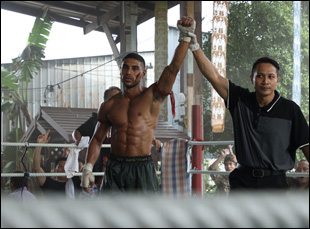
The thing was really to get that documentary style. I wanted to be handheld, close to my character and really never use a dolly or crane. We used a little bit for running in some shots, but it was important to stick to the character, really close to them [with] long lens, trying to be with them and sometimes when the rage is coming, we used a very wide lens, very close to the face. For that, I remember I read some interviews with Reed Morano on what she did on “The Handmaid’s Tale” for some of the close-ups on the actors and the way she used a long lens and a short lens close to the character, so we used the 21 mils on Nassim. And as he’s very beautiful, he can accept a very close wide lens on his face and that really helped the dynamic of the action scenes later on because they are all shot with 18 millimeters. That gives a [certain] pace, and we use the audience to see that kind of [language] visually because we use it from the very beginning.
Nassim seems like a real gift with his MMA background, but he’s been acting for years. What was it like to work with him?
It was perfect because Nassim is a very hard worker, and at the beginning, he wasn’t considered for the film. There was another actor and that other actor had a schedule conflict, so I called back Nassim to tell him, “Okay man, this is for you” and he really worked his ass off to physically be as [physically ready] as he is in the film, and he’s really good at doing that with his body. He trained a lot for the action scenes, and for the character of Sam, because in life, Nassim is very joyful and always telling jokes, but I wanted a character who was really discrete, so I was talking about Stallone in “Rocky,” and Clint Eastwood, a character [who was] really low profile, trying to be hidden from the rest of the world. And that wasn’t easy for Nassim, it was not that easy, but he embraced that and he really understood the character and going into the direction.
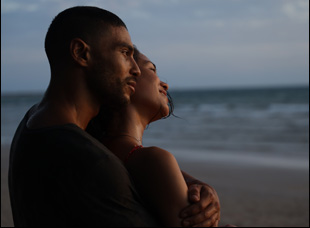
We really shot in a prison in Paris, and there is a small tribute to “Saint Ange” in it because there is a cameo of Pascal Laughier as a guardian in the prison, and Alexandre Bustillo and Julien Maury as well, the director of “Inside.” But the story of the rats at the beginning of the film is a true story, and the guy telling Nassim that is a 27-year convict who kidnapped people and did bank robberies, so he was really there with us and we really filmed him talking about his life. His name is Laurent Jacques, and that was super interesting to get someone like this to ground the story and it was important for me to blur the line between documentary and fiction.
I can’t help but ask if there were any of action scenes that you’ve been holding onto for some time and were waiting to put in a film.
The bone cracking used as a weapon at the end was really something I had in mind for a very long time, so I wanted to do it. It’s done now and I can turn the page on this one. But I have many other ideas I will express probably on my next film, and we are actually writing “Mayhem 2,” and it’s going to be much more badass than the first one.
That’s hard to imagine.
We are writing it and it’s going to be quite crazy and even more emotional because we want to keep that aspect through the film, so it’s going to be quite intense.
Is it true you already have another film in the can with Nassim? And involving sharks?
It was very funny because when we decided to do the shark movie, we were in post for “Mayhem” and I was shooting “Lupin” in the same time and I jumped directly on the shark movie. Nassim was already attached with Berenice Bejo and we shot last year and I’m actually finishing post this month, and in June, it’s going to be released everywhere on Netflix. It’s going to be a very different film from what I’ve done, so I’m really curious about what the audience is going to say about it, but I’m really excited to present it because it’s going to be something very special.
“Mayhem” opens on January 5th in New York at IFC Center and Los Angeles at the Lumiere Music Hall. It is also available on VOD.




